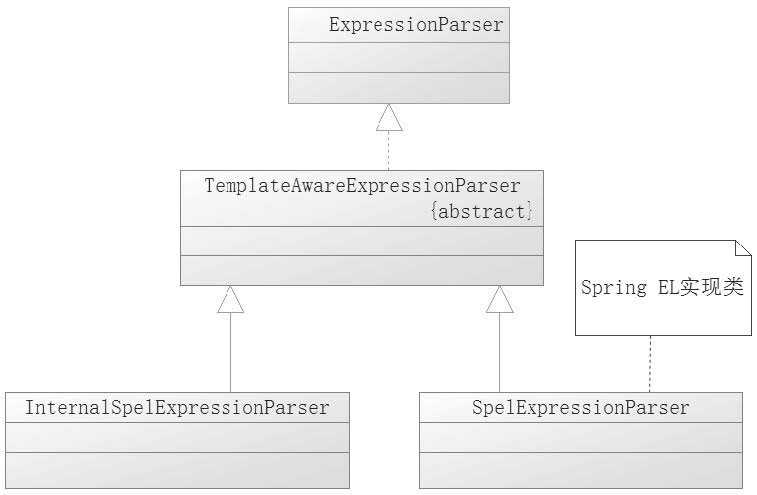标签:cat 第一个 factory 生产 实践 需要 imp 方便 nbsp
Spring还提供了更灵活的注入方式,那就是Spring表达式,实际上Spring EL远比以上注入方式强大,我们需要学习它。Spring EL拥有很多功能。
使用Bean的id来引用Bean。
•调用指定对象的方法和访问对象的属性。
•进行运算。
•提供正则表达式进行匹配。
•集合配置。
这些都是Spring表达式的内容,使用Spring表达式可以获得比使用Properties文件更为强大的装配功能,只是有时候为了方便测试可以使用Spring EL定义的解析类进行测试,为此我们先来认识它们。
简要介绍Spring EL的相关类,以便我们进行测试和理解。首先是ExpressionParser接口,它是一个表达式的解析接口,既然是一个接口,那么它就不具备任何具体的功能,显然Spring会提供更多的实现类

代码清单:举例说明Spring EL的使用
//表达式解析器 ExpressionParser parser = new SpelExpressionParser(); // 设置表达式 Expression exp = parser.parseExpression("‘hello world‘"); String str = (String) exp.getValue(); System.out.println(str); //通过EL访问普通方法 exp = parser.parseExpression("‘hello world‘.charAt(0)"); char ch = (Character) exp.getValue(); System.out.println(ch); //通过EL访问的getter方法 exp = parser.parseExpression("‘hello world‘.bytes"); byte[] bytes = (byte[]) exp.getValue(); System.out.println(bytes); //通过EL访问属性,相当于"hello world".getBytes().length exp = parser.parseExpression("‘hello world‘.bytes.length"); int length = (Integer) exp.getValue(); System.out.println(length); exp = parser.parseExpression("new String(‘abc‘)"); String abc = (String) exp.getValue(); System.out.println(abc); //表达式解析器 ExpressionParser parser = new SpelExpressionParser(); //创建角色对象 Role2 role = new Role2(1L, "role_name", "note"); Expression exp = parser.parseExpression("note"); //相当于从role中获取备注信息 String note = (String) exp.getValue(role); System.out.println(note); //变量环境类,并且将角色对象role作为其根节点 EvaluationContext ctx = new StandardEvaluationContext(role); //变量环境类操作根节点 parser.parseExpression("note").setValue(ctx, "new_note"); //获取备注,这里的String.class指明,我们希望返回的是一个字符串 note = parser.parseExpression("note").getValue(ctx, String.class); System.out.println(note); //调用getRoleName方法 String roleName = parser.parseExpression("getRoleName()").getValue(ctx, String.class); System.out.println(roleName); //新增环境变量 List<String> list = new ArrayList<String>(); list.add("value1"); list.add("value2"); //给变量环境增加变量 ctx.setVariable("list", list); //通过表达式去读/写环境变量的值 parser.parseExpression("#list[1]").setValue(ctx, "update_value2"); System.out.println(parser.parseExpression("#list[1]").getValue(ctx));
EvaluationContext使用了它的实现类StandardEvaluationContext,进行了实例化,在构造方法中将角色对象传递给它了,那么估值内容就会基于这个类进行解析。所以后面表达式的setValue和getValue方法都把这个估值内容传递进去,这样就能够读/写根节点的内容了,并且通过getRole()的例子,还可以知道它甚至能够支持方法的调用。为了更加灵活,估值内容还支持了其他变量的新增和操作,正如代码中创建了一个List,并且把List用估值内容的setVariable方法设置,其键为"list",这样就允许我们在表达式里面通过#list去引用它,而给出的下标1,则是代表引用List的第二个元素(list是以下标0标识第一个元素的)。
上面介绍了Spring具有对表达式的解析功能,Spring EL最重要的功能就是对Bean属性进行注入,让我们以注解的方式为主去学习它们。
使用注解的方式需要用到注解@Value,在属性文件的读取中使用的是“$”,而在Spring EL中则使用“#”。下面以角色类为例进行讨论,我们可以这样初始化它的属性,如代码清单所示。
代码清单:使用Spring EL初始化角色类
import org.springframework.beans.factory.annotation.Value; import org.springframework.stereotype.Component; @Component("role2") public class Role2 { //赋值long型 @Value("#{2}") private Long id; //字符串赋值 @Value("#{‘role_name_2‘}") private String roleName; //字符串赋值 @Value("#{‘note_2‘}") private String note; }
代码清单:通过Spring EL引用role的属性,调用其方法
@Component("elBean")
public class ElBean {
//通过beanName获取bean,然后注入
@Value("#{role2}")
private Role2 role2;
//获取bean的属性id
@Value("#{role2.id}")
private Long id;
//调用bean的getNote方法,获取角色名称
// @Value("#{role.getNote().toString()}")
@Value("#{role2.getNote()?.toString()}")
private String note;
@Value("#{T(Math).PI}")
private double pi;
@Value("#{T(Math).random()}")
private double random;
@Value("#{role.id+1}")
private int num;
}
AnnotationConfigApplicationContext context = new AnnotationConfigApplicationContext(ApplicationConfig3.class); Role2 role2 = context.getBean(Role2.class); System.out.println(role2.toString()); ElBean elBean = context.getBean(ElBean.class); System.out.println(elBean.toString());
有时候我们可能希望使用一些静态方法和常量,比如圆周率π,而在Java中就是Math类的PI常量了,需要注入它十分简单,在ElBean中如同下面一样操作就可以了:
@Value("#{T(Math).PI}")
private double pi;
这里的Math代表的是java.lang.*包下的Math类。当在Java代码中使用该包是不需要先使用import关键字引入的,对于Spring EL也是如此。如果在Spring中使用一个非该包的内容,那么要给出该类的全限定名,需要写成类似这样:
@Value("#{T(java.lang.Math).PI}")
private double pi;
同样,有时候使用Math类的静态方法去生产随机数(0到1之间的随机双精度数字),这个时候就需要使用它的random方法了,比如:
@Value("#{T(Math).random()}")
private double random;
这样就可以通过调用类的静态方法加载对应的数据了。
上面讨论了如何获取值,除此之外Spring EL还可以进行运算,比如在ElBean上增加一个数字num,其值默认为要求是角色编号(id)+1,那么我们就可以写成:
@Value("#{role.id+1}")
private int num;
有时候“+”运算符也可以运用在字符串的连接上,比如下面的这个字段,把角色对象中的属性roleName和note相连:
@Value("#{role.roleName + role.note}")
private String str;
这样就能够得到一个角色名称和备注相连接的字符串。比较两个值是否相等,比如角色id是否为1,角色名称是否为"role_name_001"。数字和字符串都可以使用“eq”或者“==”进行相等比较。除此之外,还有大于、小于等数学运算,比如:
@Value("#{role.id == 1}")
private boolean equalNum;
@Value("#{role.note eq ‘note_1‘}")
private boolean eqaulString;
@Value("#{role.id > 2}")
private boolean greater;
@Value("#{role.id < 2}")
private boolean less;
在Java中,也许你会怀念三目运算,比如,如果角色编号大于1,那么取值5,否则取值1,那么在Java中可以写成:
int max = (role.getId()>1? 5:1);
如果角色的备注为空,我们给它一个默认的初始值“note”,使用Java则写成:
String defaultString = (role.getNote() == null? "hello" : role.getNote());
下面让我们通过String EL去实现上述的功能。
@Value("#{role.id > 1 ? 5 : 1}")
private int max;
@Value("#{role.note?: ‘hello‘}")
private String defaultString;
实际上Spring EL的功能远不止这些,上面只介绍了一些最基础、最常用的功能,熟练运用它还需要读者们多动手实践。
文章来源:ssm10.10
标签:cat 第一个 factory 生产 实践 需要 imp 方便 nbsp
原文地址:https://www.cnblogs.com/ooo0/p/10987630.html